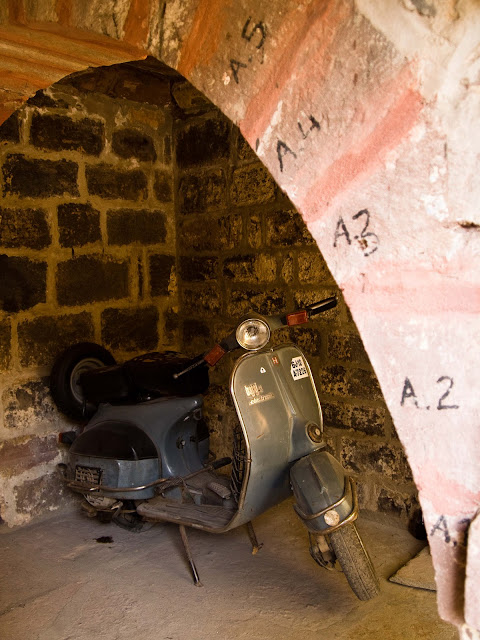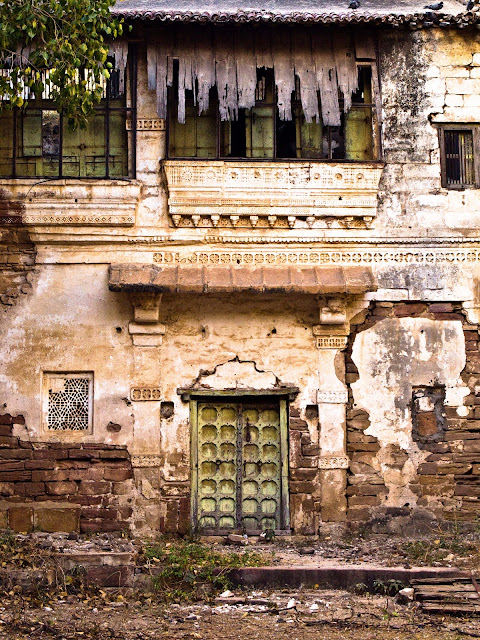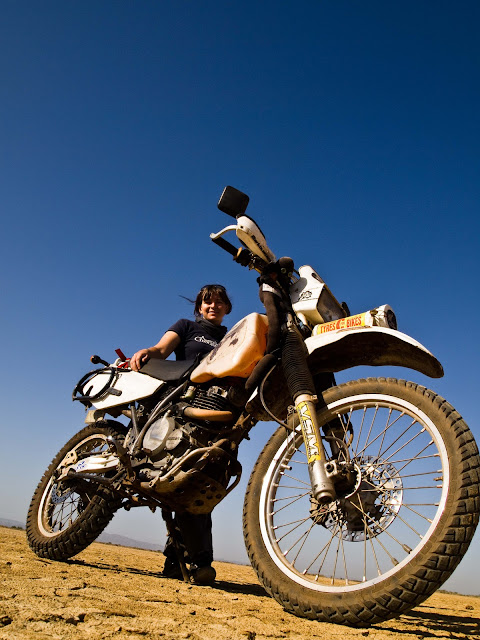The guide book was correct, Bhuj was definately the wild west of Gujarat, however, my map was completely wrong. I ended up passing a village I was hoping to stop at and possibly do a home stay with a family of block printers. Instead I arrived into the township of Bhuj and couldn't find the recommended guest house, as it was well hidden down several narrow alley ways. That afternoon I thought I should go and see the town museum, but didn't after walking around the whole complex and back to the main entrance as I couldn't find the second entrance my map showed. I couldn't believe how wrong my map was.
 |
| On my way to Bhuj I got to stop and see more salt farms. |
 |
| Should I take a tuk tuk or a camel? |
 |
| This is another one of those moments where the parents ask me to take a photo of their kid. |
 |
My attempts for finding stuff today went from bad to worse, I jumped on my bike to look for a small craft village less than 8 kilometres from the township. 15 kilometres later, I turned around ask someone, they pointed in the direction I came from, but I was past it, I just couldn't be bothered any more.
I was amazed at the completely different vibe I got from Bhuj. Everyone is so friendly, I didn't feel threatened at all. I couldn't help wondering if it was because Gujarat is an alcohol free state, or because a lot of the people here are Muslim. What ever the reason, I actually walked back to my hotel late and felt completely safe.
Rising early, I left for the white desert which is 90 kilometres north of from Bhuj. Along the way, I spotted a dried up lake to stop and take photos of myself and the bike. I had to call it quits after a while, as trucks and cars were stopping on the side of the road to watch me.
I was stopped further up the road by the police asking me to obtain my permit to travel to the Pakistan boarder. While I was in the tiny mud hut, I met an Indian doctor and his family who were also on their way out to the White Desert. As a lot of Indians are, they are really cautious people and he asked me to come with him and his family, as he thought I would get lost. Declining several times, with a thousand different reasons he eventually gave up and let me go.
I got almost there before I came to a 'T' intersection without a sign posts to tell me where I was meant to go. Luckily I had just past two Indian men that had strong Pakistan facial features, one dressed in a long purple shirt and pants, the other in a matching yellow one. Surprised to discover I was a woman, they pointed me in the right direction.
Riding out into the middle of nowhere, I came across a small masonry hut with two border guards patrolling the no man's land between India and Pakistan. I was asked to stop my bike, dismount and hand over my permission. I then had to sign a ledger, with all my details. It was kind a like a signing a note to say I promise I will come back into India! I asked if I could take a photo, but they sadly said no 'this is a border post!'
Following the dried up muddy tracks, I found myself wishing it had just rained to have some fun on the dirt. Eventually the brown turned to white as I hit the salt. Riding out past the cars heading into the middle of the vast salt flats, I felt the bike drop into a slushy part, so giving it a bit of gas I worked my way out of it, slightly frightened in case I found myself in a deeper salty puddle.
On my way back into Bhuj, I thought I would stop at some of the craft villages that I had passed this morning to get out here. Each village had its own 'main craft trade' to support its community. Not only was I looking forward to seeing all the local embroidery and mirror work (embroidered mirrors into objects like clothing, bags, blankets etc), but I had also heard the mud houses were amazing to visit.
I stopping in my first village, I was a bit disappointed in not been able to find anyone! The place was deserted or they were sick of tourist peeking into their lives. My next town on my list was Hodka, but I couldn't find the place!! Most of the signs here are in the squiggle Hindi that I really cannot understand at all.
Riding back into the small cross roads called Bhirendara, I stopped for a cold drink and a packet of chips – my first food of the day (its well past 1 pm by now). I left too early for breakfast and there was nothing to eat out in the white desert!
I headed to the next town on my list, Khavda, again it was known for mud houses and mirror work. I stopped in the one shop, the only one that was open. While I was enjoying myself looking at the work especially the copper bells, I could see a small crowd around my bike. Walking outside, everyone let me into the middle of the group.
Please click here to visit my website and play the movie
One man asked me a thousands questions about New Zealand, Australia, and my trip. One questions he asked me was, what type of meat do you eat in New Zealand? I replied as you do, you know, cows!' He looked down at me and said, 'We do not eat cows here in India, they are sacred.' I felt so bad, that I had completely screwed up! As I departed He said everyone has come to see the tiny woman on the massive motorcycle, which was pretty funny, but they were all loving it.
I moved on again, and stopped at another town – this was finally what I was expecting. Traditional mud houses with decorative mud detailing.
When I entered the house, I was welcomed by a beautiful older lady dressed in traditional Kutch mirror embroidery. She has this open home with her family, where they all sell their hand made stuff ranging from her great-grandmother to her grand daughters work. It was all amazing, they offered me chai (Tea) and I sat down on the floor and filtered through the amazing work.
Once I had spent all my money, I loaded my bike and took off. I was broke but I wanted to stop at one more place to see if it was worth coming back the following day with money.
I drove into a dusty town that reminded me of a typical Mongolian township. Driving around desperately trying to find the place. Just as I was about to give up, I found it. Tired, worn out with the lack of food and water – I also realised I was extremely sun burnt!
As I walked in and everyone turned to staring at me, I asked if there were stuff to see here, that when finally someone spoke up, 'there is, but first it chai time, so come and sit with us' Sitting down, chatted with a few of them I meet one Australian guy volunteering for the NGO. Afterwards, he showed me the museum where they had collected thousands of pieces of work from all around the district. They had completely categorised them, hoping that local people will use them to inspire themselves when creating a more modern piece.
He then showed me the work room, where everyone was busy working on the sewing machines. One woman was from Pakistan and joked she wanted to come with me and go back home! I laughed and told her to jump on and hold on tight! Everyone laughed. Then he showed me the show room – it was amazing, I found so many pieces I couldn't believe my eyes.
 |
| The lady in front is the one from Pakistan who wants to come with me. |
 |
| The show room. |
 |
| The mud work details, all done with your hands. |
That night, I went next door to the Thali restaurant. The nice owner fronting the Thali shop wanders over to me and asks me about my motorcycle, and my trip. We get talking after I have eaten a whole days worth of food in one sitting. Ok, so now I'm feeling pretty sick, and dieing to lie down, but I quickly work out he isn't just the owner for the restaurant but for the hotel I am staying in. Him and his wife are getting a house built at the moment, and he showed me the various designs that they had to choose from. I eventually managed to leave and head up to my room to rest my pot belly.
 |
| This is the one the first steps to block printing. The piece of fabric goes through about 10 - 14 steps depending on colour and design. |
 |
| They lie them out in the sun to dry before processing them again. |
 |
| This is the back yard of the block printers house. They do everything in this yard, from printing to dying. |
 |
| This is where they heat up the natural dyes. |
 |
| The have laid out all the fabrics ready for cutting |
When I started travelling, I wasn't sure how I was going to make a connection with the local women, knowing that in many countries they are not generally seen around the streets, let alone able or allowed to talk to a foreigner. Visiting small craft communities gives me a great opportunity to bridge the gap between the women and the women at home. It also gives me a great reason to get myself into the family's houses and work environment to see how the women actually live their lives.
A good friend of mine, Louise and I have decided to work together, where I find and buy fair trade products from all the amazing places I visit. After sending them back to Australia, Louise will upload them to a online shop we are currently building. I will give more details as they emerge.




































1 comment:
Wow.The detail in the buildings and mud houses is amazing. Also the mirror embroidery work. How wonderful to be able to really see it. Great photos.
Post a Comment